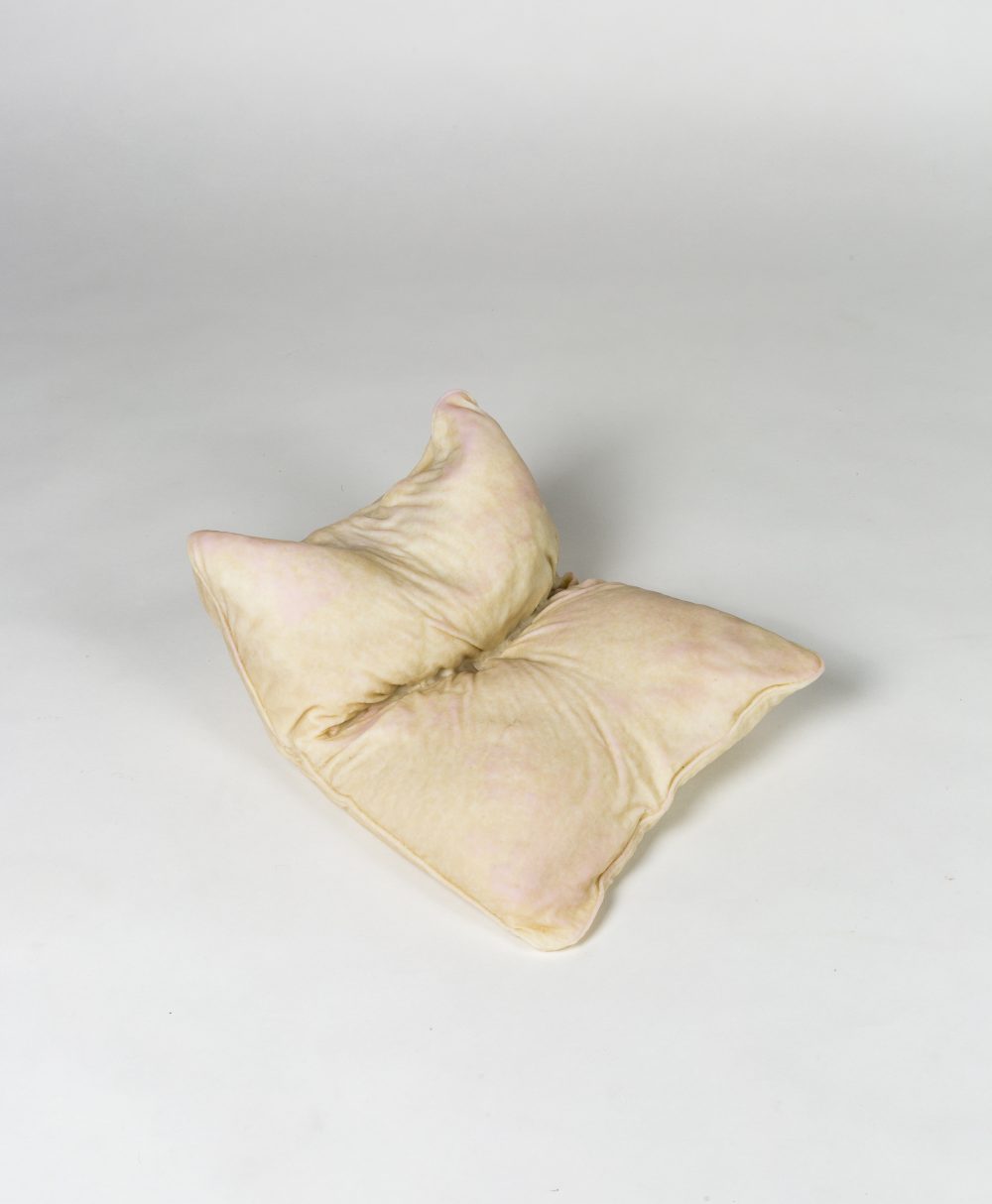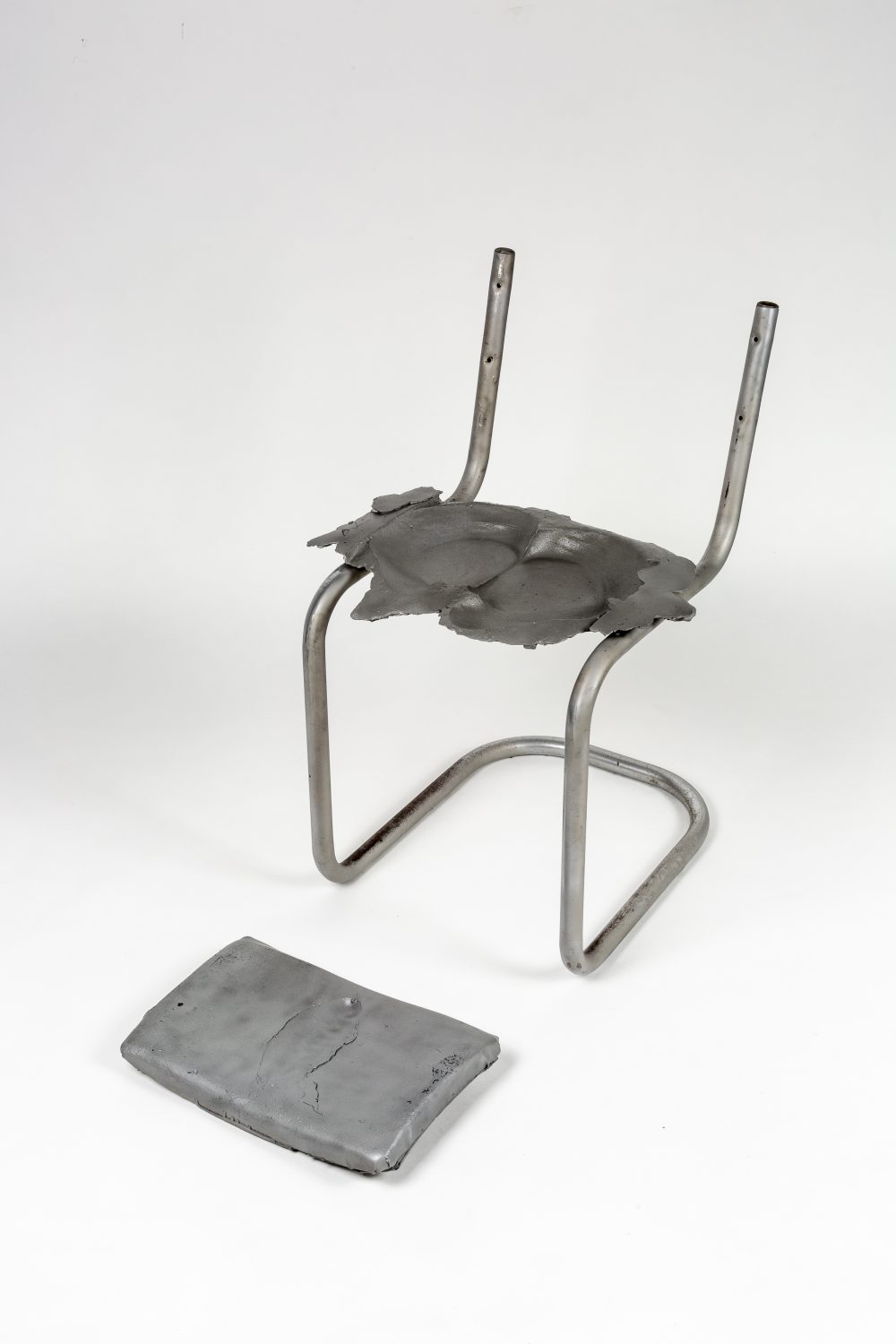Heidi Schwegler | Existential Action Thriller (EAT)
Sylvania North View Gallery
Heidi Schwegler | Existential Action Thriller (EAT)

Heidi Schwegler, Blush, 2023, glass, 7 x 13 x 5″. (Photograph: Sarah Lyon)
- Exhibition dates: March 19 – May 16, 2024
- Gallery hours: Monday – Friday, 8am-4pm, Saturdays by appointment
- Opening reception with the artist: Tuesday, March 19, 3-6pm
- Artist Talk with Heidi Schwegler and poet W. Vandoren Wheeler: Thursday, May 16, 1-2pm
Through the alteration and re-casting of everyday things, Existential Action Thriller (EAT) challenges the boundaries that delineate the self from its surrounding environment. As we coexist with these items, a subtle integration occurs, blurring the lines between our bodies and the artifacts that populate our homes. Where does the chair end and our body begin? This amalgamation gives rise to new, hybrid forms, a tangible representation of the entwined narratives of our existence.
Beyond the observable traces of biological matter in a well-used and hand-braided cotton rug purchased on eBay – a strand of hair, a cat’s claw, remnants of a corn chip, a splash of wine – our domestic objects absorb memory as the events that make up our lives are forever crystalized in their materiality.
One cannot escape the realization that these once-utilitarian items have not only outlived their purpose but the lives of their original owners. Contemplating the vibrant interconnectedness of all matter, from atoms to the fluid integration of human and object, the boundaries that define our relationships become elusive. Ultimately, EAT challenges us to confront the existential dilemma of our own transience, as the objects that surround us act as our witness.
History of Existential Action Thriller (EAT)
In early 2022, I found a four-inch porcelain shard in the Mojave Desert. Its contours were unmistakable; it was from a toilet unceremoniously abandoned in the middle of nowhere. This unremarkable shard became an ersatz conceptual totem for a project. I invited an archaeologist, forensic scientist, writer, anthropologist, and museum registrar to scrutinize and study this shard. Each participant exercised the normative models of their discipline in “interpreting” the shard. I designed and fabricated sculptural constructions in response to each participant’s findings.
When I received an invitation to present work at the North View Gallery, PCC Sylvania, I was inspired to continue this thread. I connected with a few faculty members to see if they would like to engage their students in a fragment exercise. I combed our 2-acre plot and began collecting fragments that were buried just under the top layer of the sandy soil. I arranged them in groupings, wrapped them in tissue, and shipped them off.
The outcomes of this endeavor were nothing short of inspiring. In Christine Weber’s Humanities 100 class, students selected a fragment, composed a description, and initiated a conversation with Chat GPT. Each project comprised four components: a Chat GPT-generated poem, a student-created work, a reflective paper, and an image of the fragment. Remarkably, the students’ written contributions proved to be more captivating than the Chat GPT results, which tended towards the hyperbolic. It is my hope that this exercise instilled in them a newfound appreciation for the things we tend to disregard. I will also admit that this piqued my interest in AI. Without pointing to anything specific, a few of the pieces in EAT were shaped by a “conversation” with the AI app Midjourney. It almost felt like I had an irresponsible (and hyperbolic) friend in the studio helping me muster courage and break from habit as I deliberated each step.
The turning point for the project, however, was the writing contribution by W. Vandoren Wheeler, who teaches writing and literature at PCC, titled “Form of Indeterminate Purpose.” Rather than elucidate the reasons behind its significance, I leave it to Wheeler’s writing to convey the essence of the catalyst that propelled EAT forward.
– Heidi Schwegler

Heidi Schwegler, Uncanny my fanny, 2024, found object, aluminum, 27 x 18 x 31″. Courtesy of the artist. (Photograph: Sarah Lyon)
About the artist
Heidi Schwegler works in the interstitial ruins of Beijing, Los Angeles, New York City, and suburban America. She rescues haphazardly disused scraps from the bowels of the megalopolis: chicken bones, Big Gulps, broken signs, lost shoes, crumpled pylons, and take-out containers. Plastic, fiber, and bone: these materials decay but never decompose. She resynthesizes her sources into facsimiles with cast glass, gold, silver, and wax, resulting in artwork that persists in a “living death.” Recent exhibition venues include WBG London Projects (London), Asphodel (New York), Sheldon Museum (Lincoln, NE), and the Portland Art Museum (Portland, Oregon). Schwegler is a Ford Family Fellow, a MacDowell Fellow, and a Yaddo Artist-in-Residence. Reviews of Schwegler’s work have appeared in Art in America, Art Forum, Daily Serving, ArtNews, Modern Painters, and the Huffington Post. Schwegler is the founder of the Yucca Valley Material Lab, a platform for making and thinking.
About the gallery
- Address: 12000 SW 49th Avenue, Portland, Oregon, 97219
- Hours: Monday – Friday, 8am-4pm, Saturday by appointment
- Directions: Follow signs to the bookstore and parking Lot 9. The gallery is located in the Communications and Technology (CT) building, adjacent to the bookstore, on the NE corner of the Sylvania Campus.
